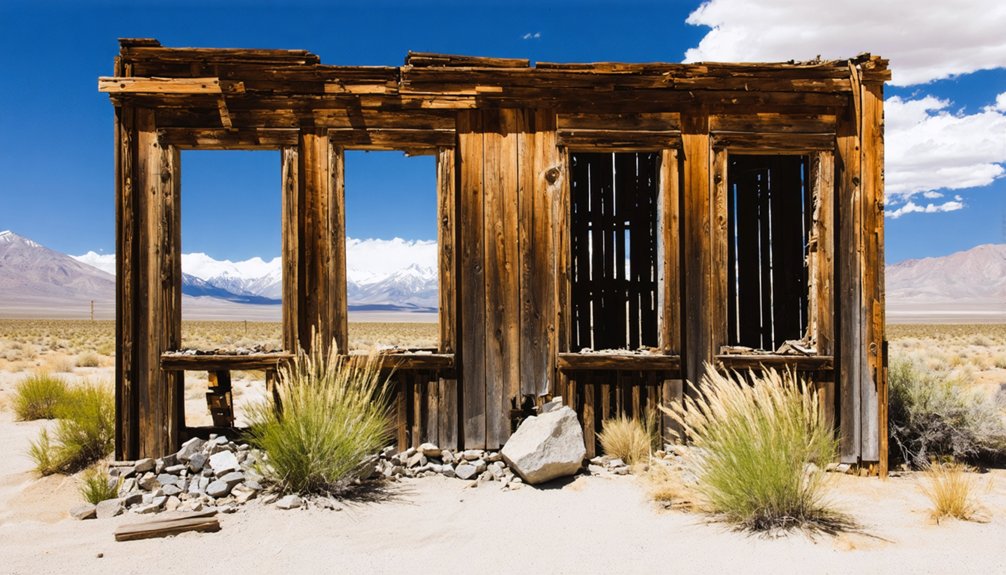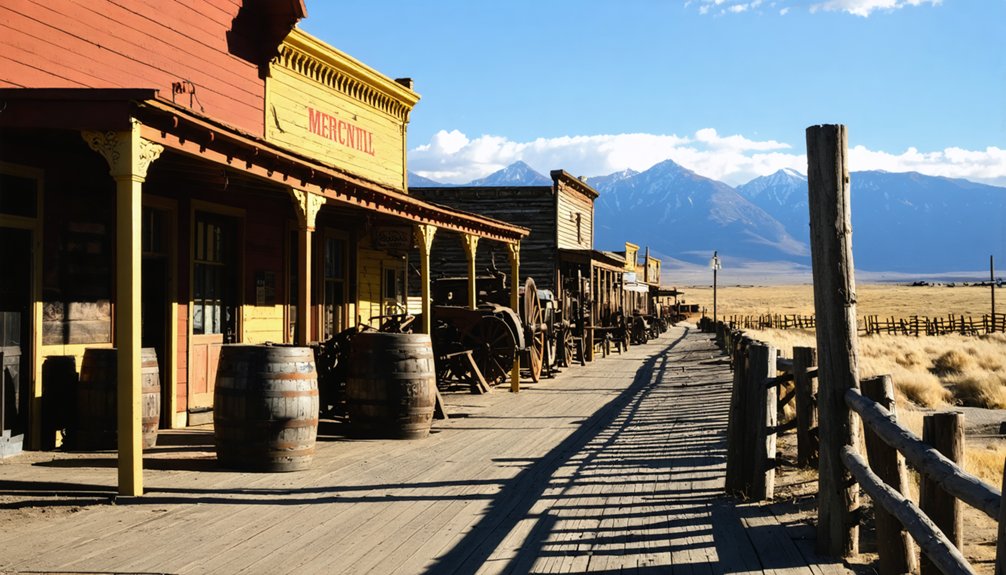You’ll find 118 Mile House among California’s Gold Rush-era ghost towns, situated exactly 118 miles from a major transport hub. This former stagecoach stop served thousands of travelers heading to Sierra Nevada mines, offering lodging, dining, and horse services during the 1850s. While the Southern Pacific Railroad’s arrival in 1876 led to its decline, you can still explore five restored 1880s buildings that showcase authentic Old West architecture and silver mining heritage.
Key Takeaways
- 118 Mile House served as a crucial stagecoach stop during California’s Gold Rush, located 118 miles from a major transportation hub.
- The site offered essential services including lodging, dining, horse care, and blacksmith facilities for weary travelers.
- After Southern Pacific Railroad’s completion in 1876, the station declined as stagecoach travel became obsolete.
- Five restored buildings from the 1880s remain at the site, preserving architectural elements from California’s Old West era.
- The location is now a recognized State Historical Landmark, though it faces ongoing preservation challenges due to weathering.
The Origins of a Stagecoach Stop
Stagecoach stops, integral to California’s 19th-century transportation network, shaped the establishment of 118 Mile House as an essential waypoint.
You’ll find its name derives from the systematic mile-marking method used along stagecoach routes, indicating its location 118 miles from a major transportation hub.
Similar to establishments like the Tennant Station, which began as a tavern in 1852, these stops emerged to meet the needs of weary travelers.
As settlement patterns expanded during the Gold Rush era, entrepreneurs recognized the strategic value of establishing rest stops at measured intervals.
The location provided horse water and drinks to passing travelers, following the common practice of Mile Houses throughout the region.
The location’s development followed the practical needs of the Butterfield Overland Stage operations, which required regular points for changing horses and invigorating passengers.
Stage stops emerged wherever Butterfield coaches needed fresh horses and weary travelers sought respite along their arduous journey.
Like its counterparts, such as the 21-Mile House and 7 Mile House, this stop emerged as a crucial link in California’s transportation infrastructure, offering indispensable services to travelers while fostering regional development along the frontier.
Life Along the Gold Rush Trail
While stagecoach stops dotted California’s early transportation routes, the paths between them told an even more compelling story of human determination.
As you’d travel these rugged trails during the Gold Rush era, you’d witness a stark landscape of struggle and hope, where mining techniques evolved from simple panning to more complex operations. The brutal reality of indigenous displacement unfolded as over 300,000 fortune seekers flooded the region. The discovery at Sutter’s Mill in 1848 sparked this massive transformation of California’s wilderness. California’s new wealth and population growth led to it entering the Union as a free state in 1850.
Key elements that defined life along these paths:
- Disease outbreaks, especially cholera, claimed countless lives as migrants endured the 2,000-mile journey.
- Native Americans faced devastating loss of hunting and gathering territories.
- Vigilante justice prevailed in makeshift camps where miners fought for claims and survival.
You’d find few who struck it rich, but many who endured nature’s harshest conditions seeking freedom in California’s promise.
Roadhouse Operations and Services

During California’s Gold Rush era, roadhouses like the 118 Mile House operated as vital hubs within the region’s transportation network, offering thorough services that extended far beyond basic lodging.
You’d find detailed roadside hospitality designed to meet diverse traveler needs: comfortable rooms for rest, well-stocked dining areas, and bustling bars where you could unwind after a long journey.
These establishments didn’t just serve humans – they provided important services for your horses too, with stables, blacksmith shops, and dedicated areas for feeding and resting your animals.
You could stock up on provisions at their general stores, get your equipment repaired, and even participate in social gatherings in their dance halls.
Family-run operations typically managed these services, adapting their offerings as transportation methods evolved through the decades.
Similar to Jimmy Iovine’s work on the film Road House, these establishments played important roles in shaping the entertainment and hospitality landscape of their era.
Daily Scenes at the Waypoint
Life at the waypoint pulsed with constant motion as stagecoaches, wagons, and riders streamed through in steady succession.
You’d witness arrival rituals unfold as distant dust clouds signaled new visitors, prompting staff to ready fresh horses and supplies. Traveler interactions filled the public spaces with a mix of languages and cultures, while gamblers and musicians created an impromptu social atmosphere. The diverse crowd included forty-niners who sought their fortunes in the goldfields.
At its peak in the 1950s, excavation crews moved over 8.5 million cubic yards of earth to construct the major transportation routes that would eventually replace these historic wagon trails.
Key aspects of daily life included:
- Constant exchange of news and survival tips between diverse wayfarers
- Regular maintenance cycles of shoeing horses and repairing wagons
- Swift handling of cargo transfers and team changes to keep traffic flowing
The weather dictated the rhythm of activities, while security measures kept order among the steady stream of miners, merchants, and immigrants passing through.
The Fading Era of Stage Travel
You’d find a stark contrast between the bustling stage stops of the 1850s and their quiet demise after the Southern Pacific Railroad’s completion in 1876, as Mile Houses transformed from essential rest points into saloons or speakeasies.
The 24-hour operation of stagecoach lines had created vibrant communities around these stops, where travelers could exchange horses, mail, and stories while seeking refuge from grueling journeys. The area later became home to the Ronald Reagan Freeway in 1994, marking a new chapter in California’s transportation history. The Coast Stage Line operated regularly through these stations from 1887 to 1901, maintaining the last remnants of the stagecoach era.
The railroad’s arrival marked the end of this era, leaving many stage stops to fade into California’s ghost town landscape, though some adapted by becoming roadhouses or historical landmarks.
Stagecoach Rest Stop Life
Three distinct groups kept stagecoach rest stops running smoothly in the American frontier: the operators who managed the facilities, the stable hands who cared for horses, and the support staff who fed and housed weary travelers.
You’d find these hardy souls working around the clock along stagecoach routes, ready for coaches arriving at any hour. Traveler tales often spoke of their dedication in the face of isolation and challenging conditions. Much like the mining boomtowns of California’s past, these stops were vital community hubs before becoming abandoned remnants of frontier life.
- Rest stops served as essential communication hubs where you’d exchange news, mail, and goods with fellow passengers.
- You’d find basic but filling frontier meals of stews and bread, often prepared by the operator’s family.
- Your safety depended on vigilant staff who stayed alert for threats from outlaws or hostile wildlife.
Daily Travel Routines
During the peak of stagecoach travel, daily routines followed strict schedules that shaped life across California’s frontier. You’d find stages departing at dawn, covering 30-60 miles per day with stops every 10-15 miles for fresh horses and quick breaks.
Passenger dynamics meant you’d share cramped quarters while conductors managed tickets and freight manifests.
Travel challenges were constant – weather delays, rough roads, and mechanical issues disrupted clockwork scheduling.
At each stop, hostlers swiftly exchanged tired horses for fresh teams while station keepers coordinated meals and lodging.
You’d witness the loading and unloading of essential cargo: mail, mining equipment, and supplies for remote settlements.
These daily patterns continued until railroads and automobiles transformed frontier travel, gradually rendering fixed stagecoach schedules obsolete.
End of an Era
As railroads expanded across California in the late 1800s, the golden age of stagecoach travel began its steady decline.
The cultural transformation was swift and irreversible, leaving once-bustling stops like 118 Mile House to face economic decline. You’ll find that by the early 1900s, most major stage lines couldn’t compete with the faster, more reliable rail transport.
Here’s what drove the final nails in the stagecoach era’s coffin:
- Rail networks provided safer, more efficient travel options
- Automobile adoption and improved highways made personal transport accessible
- Remote roadhouses lost their primary source of income as traffic patterns shifted
The last regular stagecoach service ended in the 1920s, transforming these crucial waypoints into silent witnesses of a bygone era.
Many roadhouses were abandoned or repurposed, marking the end of California’s romantic stage travel period.
What Remains Today

The weathered remains of 118 Mile House stand as a tribute to California’s mining era, with five restored buildings from the 1880s showcasing authentic Old West architecture.
You’ll find carefully preserved homes, shops, and public buildings that highlight the architectural preservation efforts maintaining historical significance from the silver mining boom period.
As you explore the semi-arid landscape, you’ll notice the original town layout remains largely intact, though many buildings have succumbed to time.
While the site’s recognized State Historical Landmark status helps protect these structures, you’ll see evidence of ongoing challenges from natural weathering and limited maintenance funds.
Mine shafts, now fenced off for safety, dot the surroundings, and rusted mining equipment serves as a stark reminder of the town’s industrial past.
Frequently Asked Questions
Were There Any Notable Crimes or Shootouts Reported at 118 Mile House?
Like ghostly encounters fading into mist, you won’t find documented evidence of notable crimes or shootouts here. Despite the era’s lawlessness, no specific law enforcement incidents are officially recorded.
What Indigenous Tribes Originally Inhabited the Area Around 118 Mile House?
You’ll find the Secwepemc (Shuswap) and Tsilhqot’in Native tribes were the original inhabitants, maintaining their cultural heritage through hunting, fishing, and gathering in this region of British Columbia’s interior plateau.
Did Any Famous Historical Figures Stay at 118 Mile House?
Just as many footprints in sand fade with time, there’s no evidence of any famous historical figures staying at this location. No documented famous visitors contribute to its historical significance as a farming settlement.
What Was the Average Cost for Lodging and Meals in 1850S?
You’d pay astronomical prices for lodging – up to $1 million in today’s dollars for a tent, while meals could cost you $43 for breakfast alone, regardless of lodging quality.
Were There Any Natural Disasters That Affected 118 Mile House?
You won’t find clear records of specific natural disasters at this location, though nearby areas experienced earthquake impact on Highway 118 and fire damage in surrounding Ventura and Los Angeles counties.
References
- https://patch.com/california/banning-beaumont/13-ghost-towns-explore-california
- https://www.youtube.com/watch?v=amxKw6J5CHE
- https://www.californist.com/articles/interesting-california-ghost-towns
- https://dornsife.usc.edu/magazine/echoes-in-the-dust/
- https://www.youtube.com/watch?v=ElbXVNDurPc
- https://nvtami.com/2025/07/21/five-mile-house-on-the-road-to-bodie-and-aurora/
- https://www.historicplaces.ca/en/rep-reg/place-lieu.aspx?id=19488
- http://freepages.rootsweb.com/~gtusa/history/ontheroad/us6a.htm
- https://en.wikipedia.org/wiki/Millwood
- https://en.wikipedia.org/wiki/21-Mile_House



